-
 Published: Aug 7, 2025
Published: Aug 7, 2025
-
 11 min. read
11 min. read
-
Summarize in ChatGPT
-
 Maria Carpena
Maria Carpena Lead Emerging Trends & Research Writer
Lead Emerging Trends & Research Writer
- Maria is a Lead Emerging Trends & Research Writer at WebFX. With nearly two decades of experience in B2B and B2C publishing, marketing, and PR, she has authored hundreds of articles on digital marketing, AI, and SEO to help SMB marketers make informed strategic decisions. Maria has a degree in B.S. Development Communication major in Science Communication, and certifications in inbound marketing, content marketing, Google Analytics, and PR. When she’s not writing, you’ll find her playing with her dogs, running, swimming, or trying to love burpee broad jumps.
Table of Contents
- What is citation-conversion balance?
- Why is citation-conversion balance important?
- Optimize landing pages with the I.M.P.A.C.T. framework
- I: Investigate your ICP
- M: Map content to pain points
- P: Provide authority and credibility signals
- A: Align conversion points with value and strategy
- C: Craft content for dual audiences
- T: Track both citation and conversion metrics
- Future-proof your landing pages for citation-conversion balance with WebFX
Key Takeaways:
- Citation-conversion balance is a strategic approach to optimizing your landing pages to get mentioned in AI search results (citation) and to convert visitors.
- Use the I.M.P.A.C.T. framework to achieve and keep your landing page’s citation-conversion balance:
- I: Investigate your ideal customer profile (ICP)
- M: Map content to your ICP’s pain points
- P: Provide authority and credibility signals
- A: Align conversion points with value and strategy
- C: Craft content for dual audiences
- T: Track both citation and conversion metrics
Are your landing pages optimized for the new era of search?
In the past, landing pages were primarily tailored to convert visitors into leads and drive sales. Today, though, they must also be optimized to get cited in AI Overviews and generative AI results as trustworthy sources.
Why? Searcher behavior and search engines are evolving.
Traffic from AI platforms like ChatGPT is growing 165 times faster than organic search. Search engines are synthesizing information from landing pages and presenting them as summaries to users.
Before your prospect lands on your landing page, an AI tool has already shown your audience summarized information, potentially influencing their perception of your brand. This new reality is reshaping the role of landing pages in 2026.
For landing pages to become effective in this new era of search, brands need a new approach. Enter the citation-conversion balance, an approach that optimizes landing pages for AI citation and visitor conversion.
Let’s go through these topics to refresh your landing page strategy in 2026:
- What is citation-conversion balance?
- Why is citation-conversion balance important?
- The I.M.P.A.C.T. framework for optimizing landing pages for citation-conversion
What is citation-conversion balance?
Citation-conversion balance is a strategic approach to optimizing your landing pages for two purposes:
- Capture the attention of your prospects by getting mentioned in AI search results as a reputable business
- Nurture landing page visitors to convert into a lead or sale
Why is citation-conversion balance important?
Think of citation and conversion as yin and yang. You might think they’re opposing strategies, but they can co-exist and complement each other.
Together, they can improve your brand familiarity and nurture your prospects to convert.
A citation-focused approach prioritizes getting mentioned in AI-generated results. This strategy helps you:
- Improve your visibility in AI searches
- Reach prospects during their early research stage
- Position your business as a reliable expert in the field, especially when you’re frequently cited for different queries
Meanwhile, a conversion-biased approach prioritizes driving traffic to your pages and moving users to perform your desired actions, such as:
- Subscribing to your newsletter
- Signing up as a lead
- Purchasing from you
A citation-conversion balanced approach enables you to achieve the goals of each strategy. To better visualize how this balanced approach works, let’s say you own a travel agency.
When your landing pages are optimized for citation, your website can get mentioned in relevant queries in answer engines, such as Perplexity, as shown in the example below.
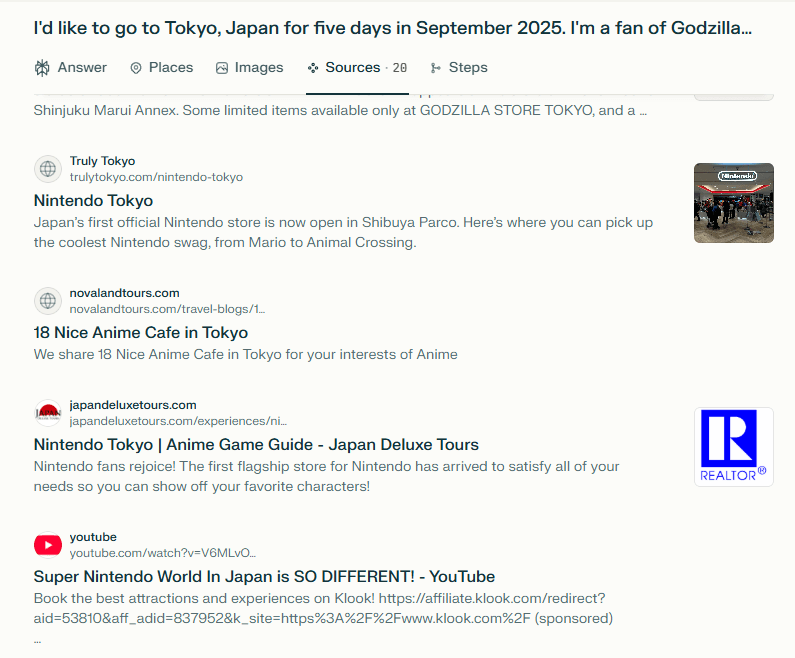
If a searcher repeatedly sees your travel agency on answers after follow-up questions, they’ll get the impression that you’re a trustworthy business in the industry. Consequently, they’ll click and reach your landing page, where you can potentially nurture them to conversion.
At this stage, you’ve successfully led them to your online storefront through an AI platform, which converts 23% better than organic traffic, according to our analysis of 1 billion search sessions.
With a citation-conversion balanced approach, your landing pages are primed to move your visitors to convert. Your calls to action (CTA) are strategically located to make it easier for users to sign up for your newsletter or get a quote for a tour package.
This balanced approach is a sustainable strategy to keep your travel agency visible in AI searches and get a steady flow of leads from your landing pages.
Optimize landing pages with the I.M.P.A.C.T. framework
To strike a balance between citation and conversion, we came up with a framework for optimizing landing pages in the age of AI search called I.M.P.A.C.T.:
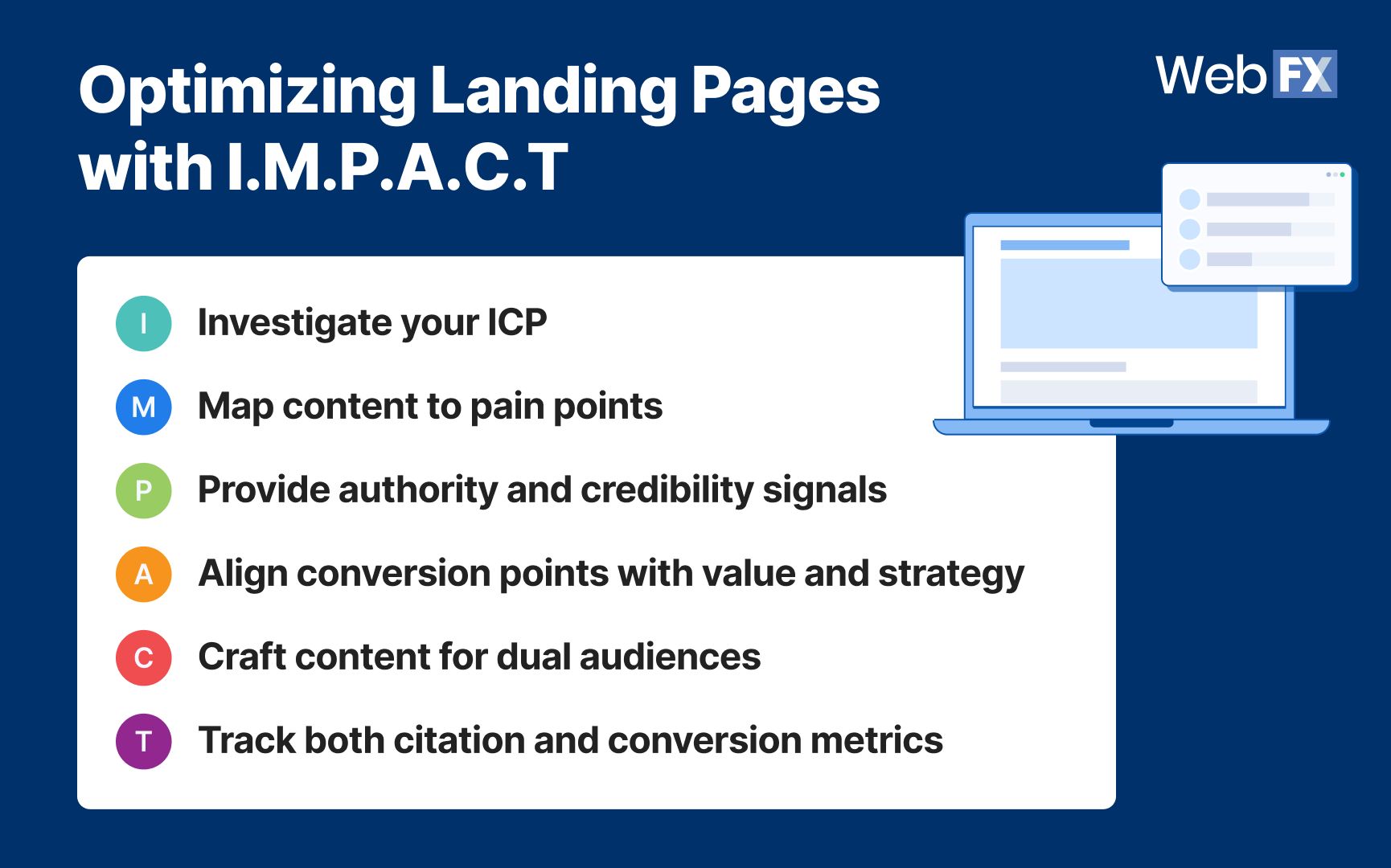
This framework summarizes best practices to increase both your visibility in AI searches and your landing pages’ conversion rates. Let’s take a closer look:
I: Investigate your ICP
Start by having a deep understanding your ideal customer profile’s (ICP’s) needs and pain points. Find out the language they use when they turn to AI-powered tools to find relevant answers.
Here are ways to implement this:
- Use social listening tools to capture your audience’s sentiments and discover how they describe their challenges
- Analyze online reviews, customer feedback, and customer support conversations
- Research specific questions that your ICP asks AI tools about your offerings
- Segment your audience based on their needs
By knowing your ICP well, you can craft helpful, informative landing pages that AI can quote and cite. In addition, you can develop marketing messages that resonate with your ICP and gain their trust, which leads to conversion.
In our travel agency example, you can use different methods to learn more about your ICP and segment them. You can segregate them according to their travel group size, budget, or destinations.
Then, uncover each segment’s most important travel preferences or biggest motivations for traveling. Understand their travel package deal breakers.
These insights will help you optimize content for landing pages (for citation). They’ll also inform you of your ICP’s decision factors, which can drive them to convert.
M: Map content to pain points
Turn your solid understanding of your customers’ needs into strategies that will inform your landing page’s content. Create landing pages that address your ICP’s needs or pain points.
Immediately answer your ICP’s question of “What’s in it for me?” AI platforms prefer content that provides information that addresses a specific audience’s need over generic, regurgitated information, thus increasing your chances of getting cited.
Use your ICP’s language. State their problems using the terms they use to let them know that you understand their struggles. Then, present a solution to their problem (conversion).
Let’s look at our travel agency example again. If the agency is developing citation-conversion balanced landing pages, they may discover that their customers tap AI tools for itinerary planning.
Travelers will typically provide contextual information, such as their destination, their travel companion, their preferences, and the duration of their trip. For example, they may prompt an AI tool with “I’m travelling to Athens, Greece alone for a week in October. What clothes should I pack for my trip? What places should I visit and things to do? I like the outdoors and enjoy eating, so you can recommend dishes that I should try.”
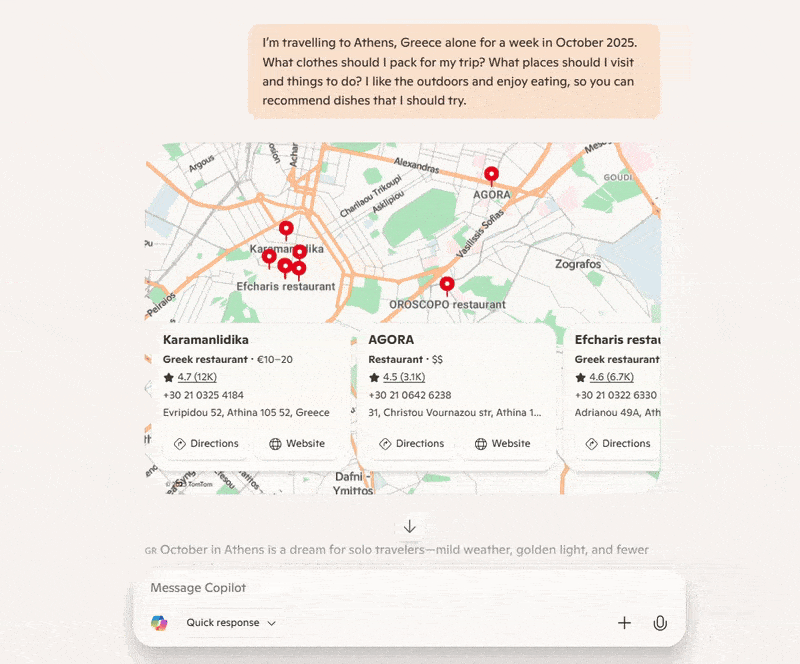
A travel agency’s balanced landing page can structure a landing page with the working headline of “7-Day Athens, Greece Itinerary for a Foodie’s Outdoor Adventure.” The landing page can have a list of recommended restaurants and outdoor activities, which makes the page easy for AI tools to process and cite.
To optimize it for conversion, the landing page can have a downloadable seven-day guide that users can save as an image or PDF in exchange for their email address.
P: Provide authority and credibility signals
Give your audience and AI systems evidence that you’re a reliable business. Testimonials, positive reviews, and awards are trust signals, which keep the citation-conversion balance in your landing pages.
By establishing your trustworthiness, you increase your chance of getting cited by AI search results. That’s because AI platforms also consider your online reputation.
Meanwhile, users are likely to trust businesses with positive reviews from past customers. In fact, 85% of consumers trust online reviews as much as personal recommendations, so they’ll likely sign up as a lead or purchase from you.
Here are other ways to establish your authority in your niche:
- Showcase your industry credentials: AI systems can analyze a brand’s authority through on-page signals (like credentials mentioned on your page) and off-page signals (which are citations from reputable websites).
- Include an excerpt from your original research (and linking to it, too!): As AI systems become more advanced, they are being trained to spot expertise indicators. As a result, original research and studies become valuable signals because your business is contributing new knowledge.
- Add unique insights from your case studies: AI systems prioritize original information, and your insights from case studies demonstrate experience and expertise.
Our travel agency example can also mention in their landing pages their average review rating on Google or other reputable review websites.
A: Align conversion points with value and strategy
Identify the most suitable CTA for your landing pages. Make sure it’s aligned with your ICP’s intent.
In addition, your content and CTA must complement each other. Together, they address your ICP’s needs.
Ensure your CTAs are strategically placed on your landing page. Test their placements, and use heat maps to measure their effectiveness.
Going back to our travel agency example, let’s say a searcher is in the early stages of looking for family- and kid-friendly tour packages in a particular city. They asked an AI tool for things to do and must-visit spots.
Your landing page content can provide useful information, such as attractions’ operating hours and why they’re best for families with young kids (citation). Instead of a CTA that nudges them to book a particular tour package, consider helping them pick the right tour package with an interactive quiz asking them about their preferences (conversion).
Based on their quiz’s results, your landing page will shortlist suitable packages. You can ask them to leave their email, where you can send their results, which they can review later.
Your helpful content and CTAs work well to help your ICP and get the attention of AI systems to mention you in their results.
C: Craft content for dual audiences
The modern and balanced landing pages of today speak to two audiences: AI platforms that cite content and humans who will convert. Ensure your landing page is easy for both of them to process your content.
Having these audiences in mind, you must strategically format your content to make it easy for machines to read it and for humans to skim it. The good news is that most technical search engine optimization (SEO) best practices still apply to getting mentioned in AI searches, such as:
- Implement schema markup
- Use bulleted lists and concise paragraphs
- Mind your page’s readability to make it easy for humans to scan
- Add multimedia elements when necessary to help humans understand your messages
- Have a clear and logical content hierarchy with proper heading tags
Based on observations, landing pages with clear content hierarchies are cited more frequently in AI searches, because they effectively show the relationships between concepts that AI platforms must understand.
Humans are also likely to convert on well-structured pages. As a consumer, I’ll likely trust a business with my email address when its website is professional-looking. And most people do, too: 38% of people will stop engaging with a page if the content or layout is unattractive.
T: Track both citation and conversion metrics
To ensure your landing pages remain visible in AI searches and drive conversions, you have to monitor and measure their success. Track both AI citation frequency and conversion coming from AI traffic to get a clear picture of your landing page’s performance and citation-conversion balance.
Here are key metrics to track:
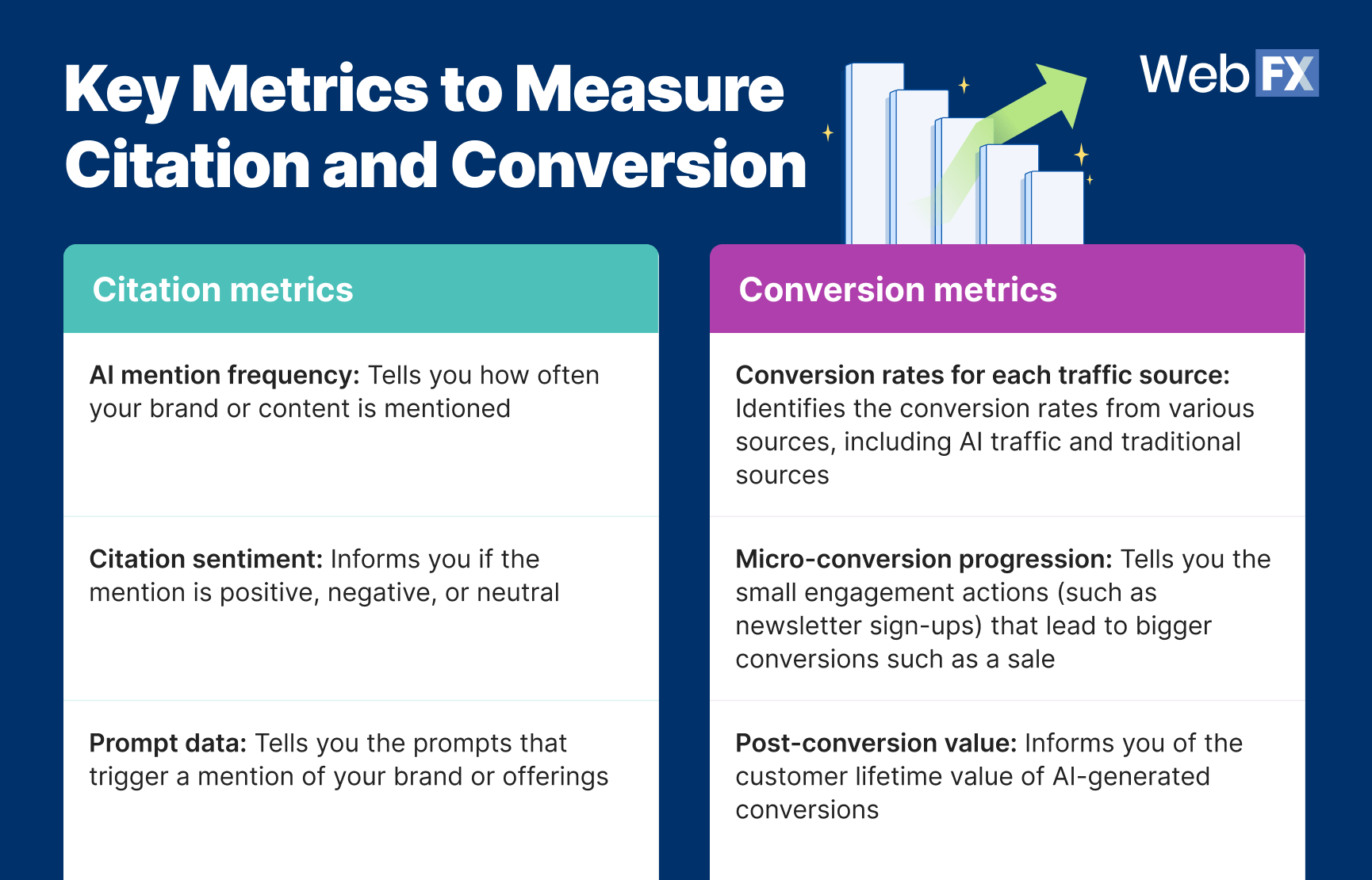
Table View ⬇️
| Citation metrics | Conversion metrics |
| AI mention frequency: Tells you how often your brand or content is mentioned | Conversion rates for each traffic source: Identifies the conversion rates from various sources, including AI traffic and traditional sources |
| Citation sentiment: Informs you if the mention is positive, negative, or neutral | Micro-conversion progression: Tells you the small engagement actions (such as newsletter sign-ups) that lead to bigger conversions such as a sale |
| Prompt data: Tells you the prompts that trigger a mention of your brand or offerings | Post-conversion value: Informs you of the customer lifetime value of AI-generated conversions |
Tracking these metrics can inform you if your landing pages are exhibiting balance. To make sense of these metrics and numbers, here’s what you can do with them:
- Establish your baseline numbers: Determine your landing page’s current performance. Use those as your baseline data.
- Look for patterns and correlations: Are there correlations between certain citation and conversion metrics? Categorize your landing pages based on their citation and conversion performance:
- Citation leaders: These are pages with content that frequently get mentioned
- Conversion drivers: These are landing pages that effectively nudge visitors to take action
- Balanced pages: Refer to landing pages that perform well in both citation and conversion
- Perform a quadrant analysis and optimize your pages accordingly: Categorize your landing pages according to their citation and conversion performances. Then, identify optimization tactics you must employ.
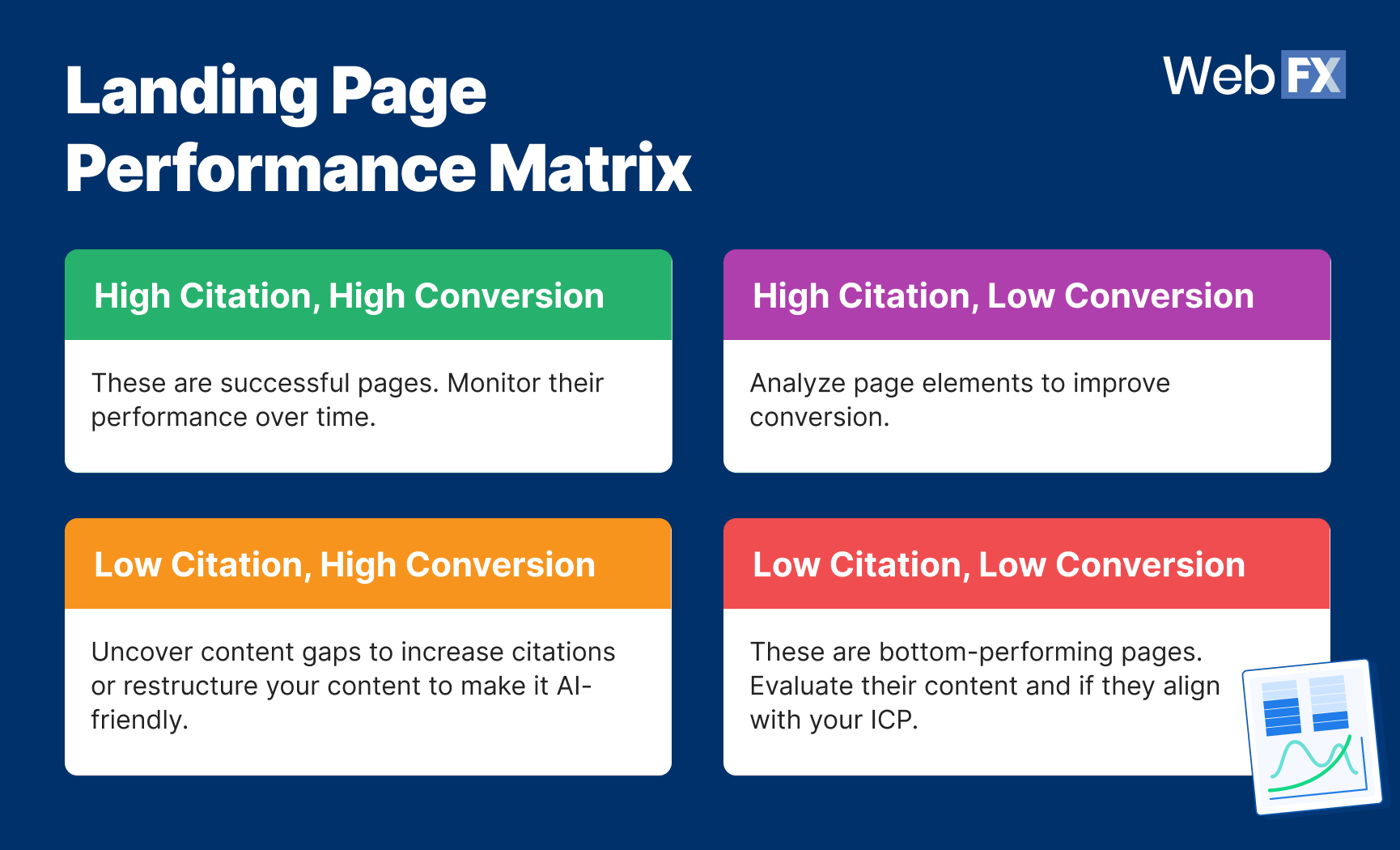
Table View ⬇️
High Citation, High Conversion
These are successful pages. Monitor their performance over time.High Citation, Low Conversion
Analyze page elements to improve conversion.Low Citation, High Conversion
Uncover content gaps to increase citations or restructure your content to make it AI-friendly.Low Citation, Low Conversion
These are bottom-performing pages. Evaluate their content and if they align with your ICP. - Test and track performance: Measure the impact of your optimization efforts. Find out if the changes improved the landing page’s citation or conversion, or had adverse effects.
Future-proof your landing pages for citation-conversion balance with WebFX
Landing pages are no longer just avenues for conversion – they’re pages that increase your brand familiarity among your prospects.
If achieving citation-conversion balance seems like a daunting task, consider teaming up with WebFX. Our generative engine optimization (GEO) services can improve your visibility in AI searches and drive conversions among your site visitors.
Contact us online or call us at 888-601-5359 to get started!
-
 Maria is a Lead Emerging Trends & Research Writer at WebFX. With nearly two decades of experience in B2B and B2C publishing, marketing, and PR, she has authored hundreds of articles on digital marketing, AI, and SEO to help SMB marketers make informed strategic decisions. Maria has a degree in B.S. Development Communication major in Science Communication, and certifications in inbound marketing, content marketing, Google Analytics, and PR. When she’s not writing, you’ll find her playing with her dogs, running, swimming, or trying to love burpee broad jumps.
Maria is a Lead Emerging Trends & Research Writer at WebFX. With nearly two decades of experience in B2B and B2C publishing, marketing, and PR, she has authored hundreds of articles on digital marketing, AI, and SEO to help SMB marketers make informed strategic decisions. Maria has a degree in B.S. Development Communication major in Science Communication, and certifications in inbound marketing, content marketing, Google Analytics, and PR. When she’s not writing, you’ll find her playing with her dogs, running, swimming, or trying to love burpee broad jumps. -

WebFX is a full-service marketing agency with 1,100+ client reviews and a 4.9-star rating on Clutch! Find out how our expert team and revenue-accelerating tech can drive results for you! Learn more
Try our free Marketing Calculator
Craft a tailored online marketing strategy! Utilize our free Internet marketing calculator for a custom plan based on your location, reach, timeframe, and budget.
Plan Your Marketing Budget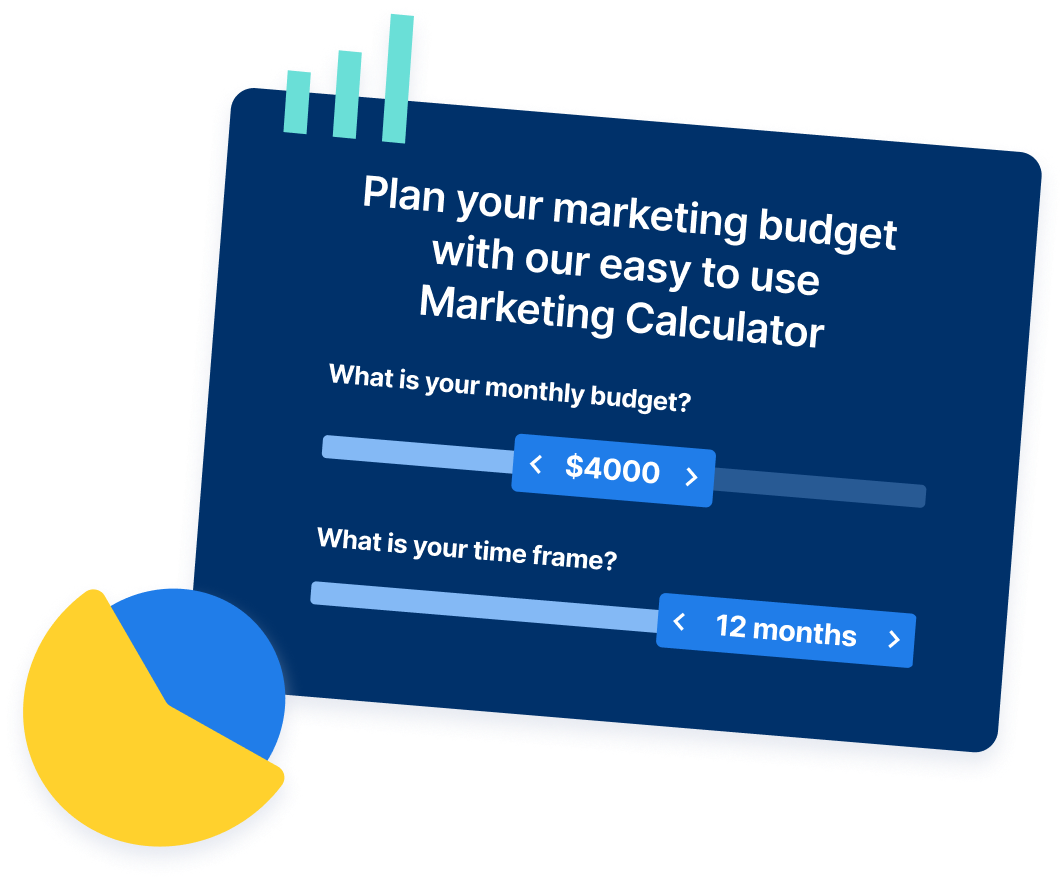
Table of Contents
- What is citation-conversion balance?
- Why is citation-conversion balance important?
- Optimize landing pages with the I.M.P.A.C.T. framework
- I: Investigate your ICP
- M: Map content to pain points
- P: Provide authority and credibility signals
- A: Align conversion points with value and strategy
- C: Craft content for dual audiences
- T: Track both citation and conversion metrics
- Future-proof your landing pages for citation-conversion balance with WebFX

Proven Marketing Strategies

Proven Marketing Strategies
Try our free Marketing Calculator
Craft a tailored online marketing strategy! Utilize our free Internet marketing calculator for a custom plan based on your location, reach, timeframe, and budget.
Plan Your Marketing Budget
What to read next




